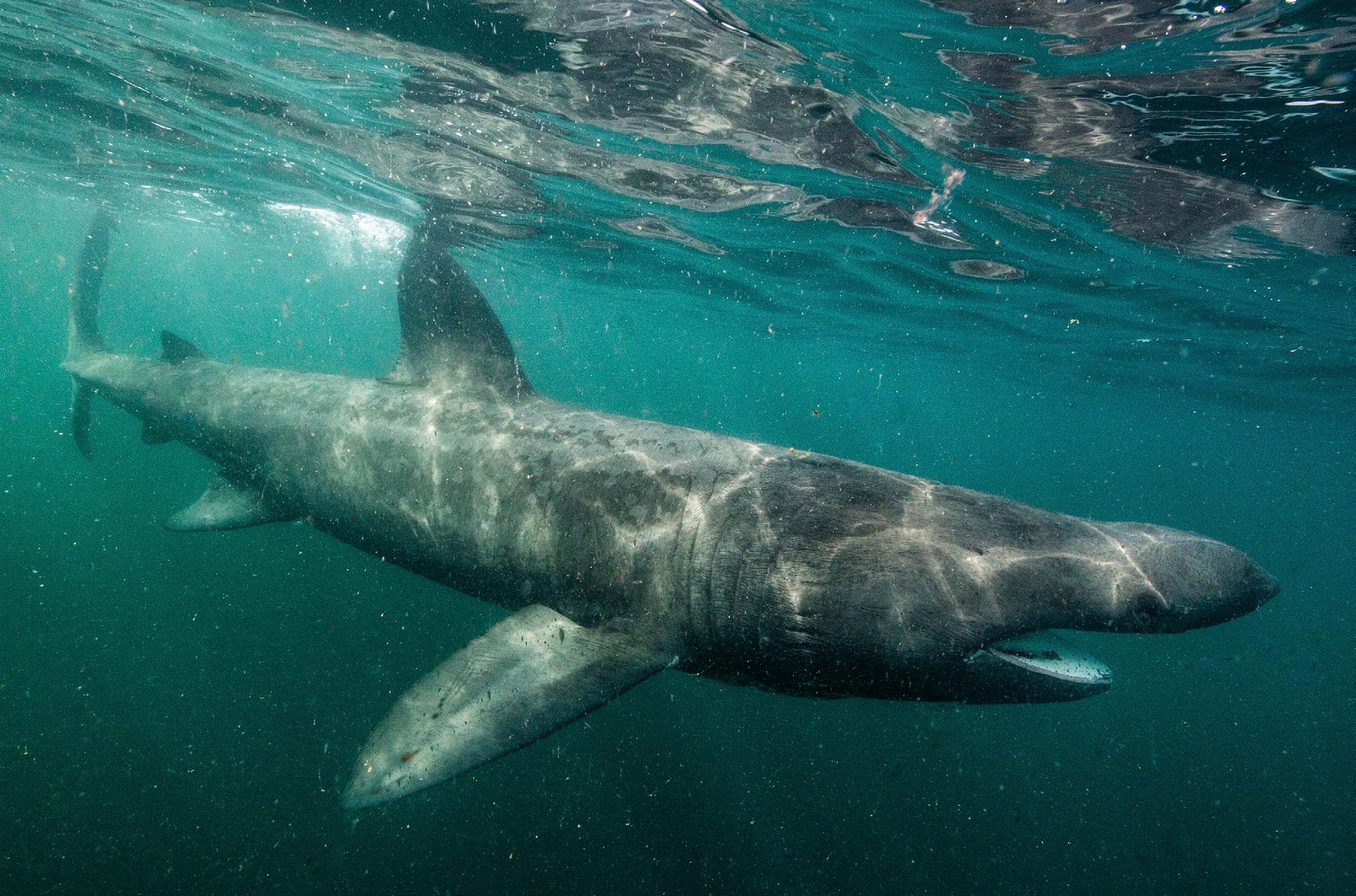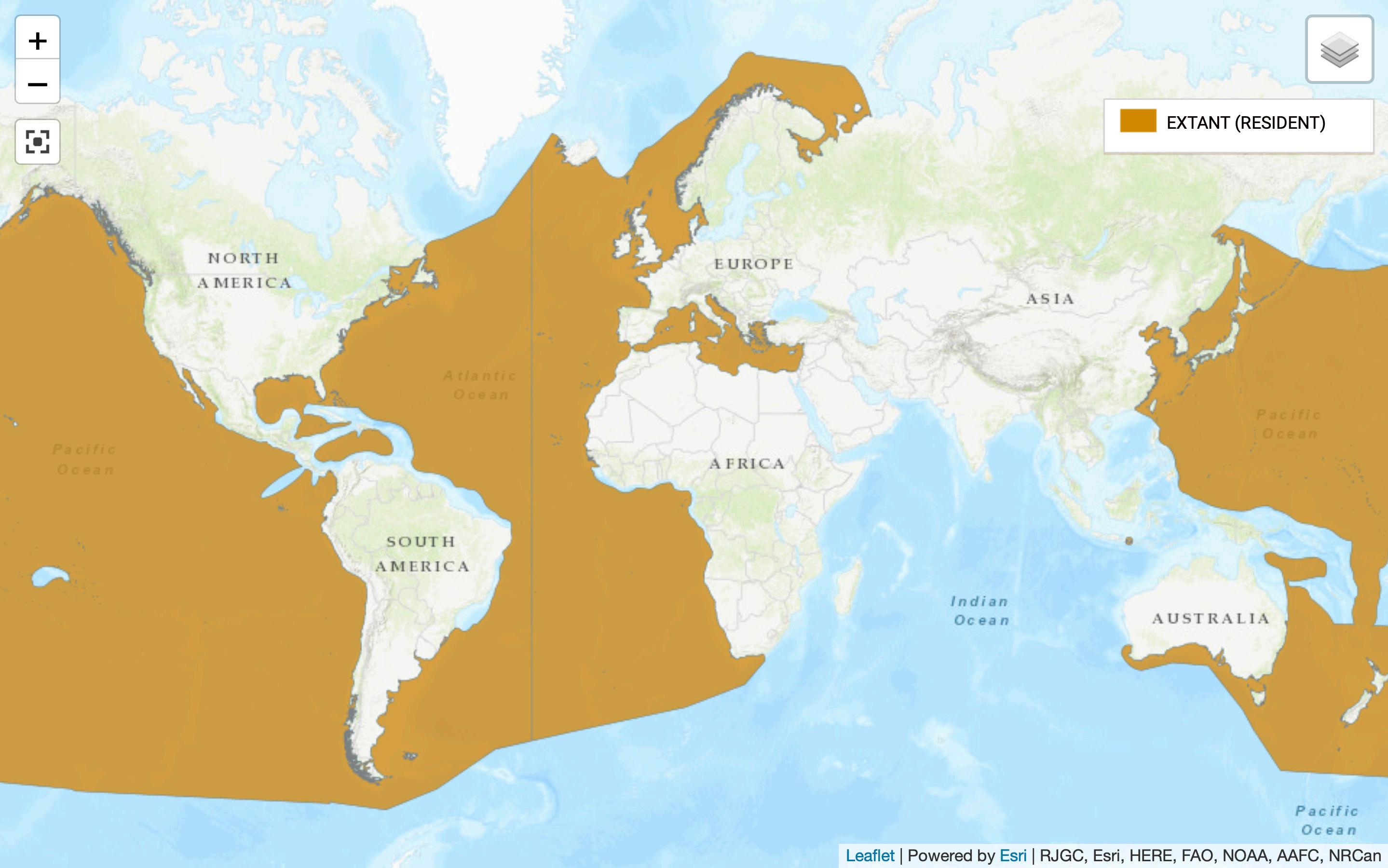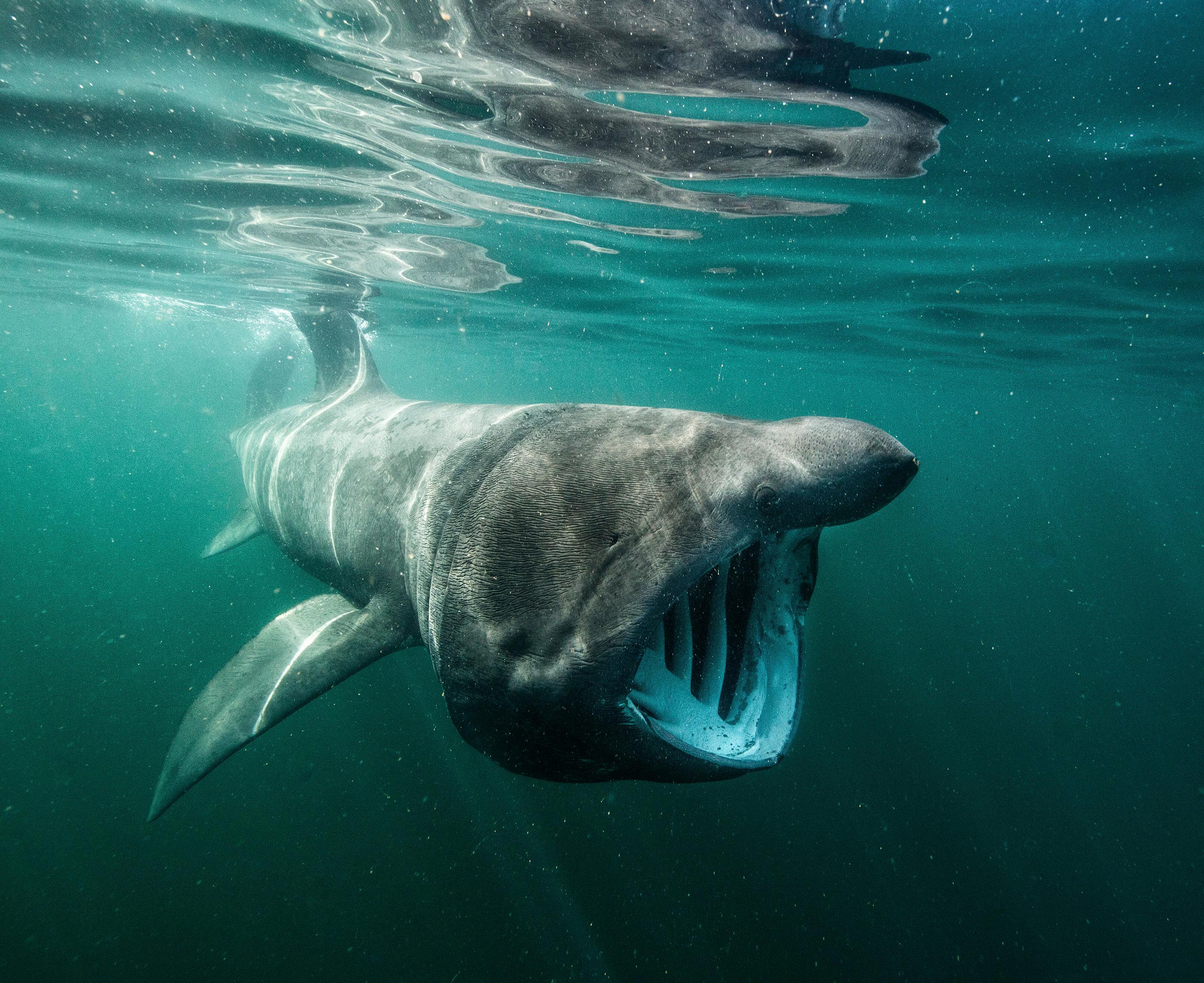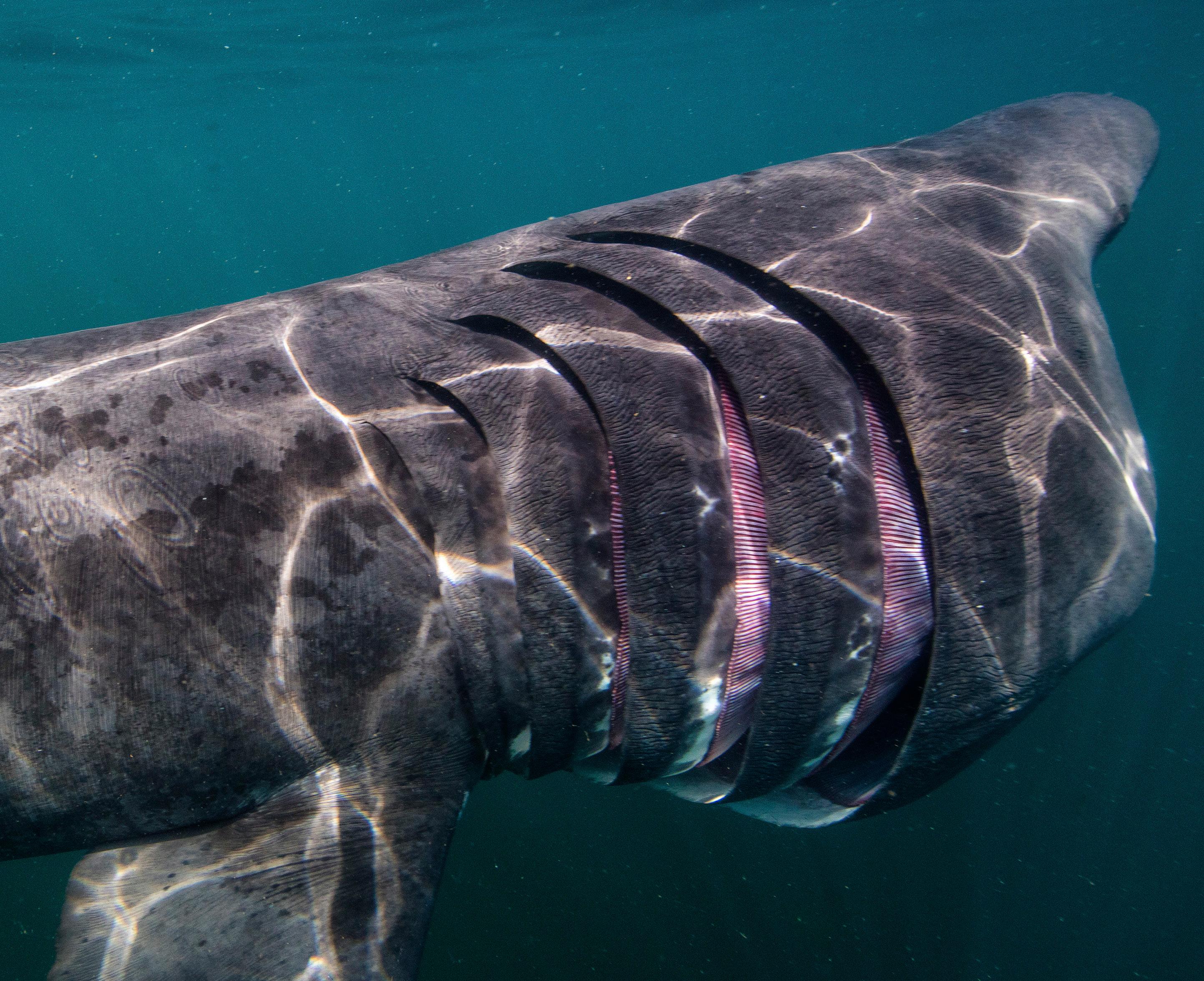
11 minute read
Feature Creature
BASKING SHARK CETORHINUS MAXIMUS
FEATURE IUCN RED LIST 2019 PHOTOGRAPHY SIMONE CAPRODOSSI ( )
Advertisement
RED LIST CATEGORY & CRITERIA: ENDANGERED
Scientific Name: Cetorhinus maximus
Synonyms: Squalus maximus Gunnerus, 1765
Common Names: English: Basking Shark
French: Pelerin
Spanish; Castilian: Peregrino
JUSTIFICATION
The Basking Shark (Cetorhinus maximus) is a very large (to ~1,100 cm total length), highly migratory, filter-feeding shark distributed mainly in the Atlantic and Pacific Oceans in coastal and pelagic habitats from the surface to 1,264 m. It occurs near the surface in temperate waters and deeper, below the thermocline, in tropical waters. The species has low biological productivity with limited fecundity and late age-at-maturity. Although no longer targeted, it is still caught as bycatch in trawl, trammel nets, and set-net fisheries, and becomes entangled in pot lines.The large fins are extremely valuable in the fin trade.Across regions, there have been some severe historic decline, however there are indications of some stability and possible slow recovery since cessation of target fishing and high levels of protection. The global population may now be beginning to stabilise, with signs of that from the Northeast Atlantic, although elsewhere there is little information upon which is assess stability. However, abundances are still estimated to be well below historic levels and there is ongoing demand for the highvalue fins, and a global population reduction of 50-79% is suspected over the past three generations (102 years). Therefore, the Basking Shark is assessed as Endangered.
GEOGRAPHIC RANGE
The Basking Shark occurs mainly in the Atlantic and Pacific Oceans; in the Indian Ocean, it is reported only from southern Australia, Indonesia, and South Africa (Ebert et al. 2013, Fahmi and White 2015).

POPULATION
There is no data on the absolute global population size, although it is likely to be greater than 20,000 individuals (and thus not approaching the thresholds for criterion C: small population size and decline). Genetic results indicate one global population (Noble et al. 2006, Francis 2017). Basking Shark total abundances have been estimated for a number of regions: 4,200 and 632 (CI: 377-1,058) in the Bay of Fundy, Canada in 2007 and 2011, respectively (Campana et al. 2008, Westgate et al. 2014); 10,125 in Canadian Northwest Atlantic waters in 2007 (highly uncertain estimate) (Campana et al. 2008); 6,671-14,925 in New England shelf waters, United States in 1982 (Kenney et al. 1985); 985 on the west coast of Scotland in 2010 (95% CI: 495-1,683) (Gore et al. 2016); and, possibly 19,151 (+/- 10,629) for Scotland and Ireland combined (Gore et al. 2013).
Landings and sightings data are available from the Northeast Atlantic (e.g. CITES 2002, Southall et al. 2005, Speedie et al. 2009, Witt et al. 2012, ICES 2018); landings data are available from Japanese waters (Yokawa 2017); and, sightings-per-unit-effort (SPUE) are available from New Zealand (Francis 2017, M. Francis unpubl. data).
In the Northeast Atlantic, the landings of Basking Sharks declined dramatically during the period 1946-2017 (CITES 2002, ICES 2018). Landings within ICES Subareas 1-14 peaked in the mid-1960s and mid-1970s at around 5,000 tonne (t), declined rapidly during the 1980s to less than 1,000 t annually, after which there was a peak in 1992 of 1,697 t, followed by a rapid decline. There is evidence of serial exploitation and depletion patterns in different ICES Subareas during this fishery. For example, the ar tisanal Achill Island fishery, which targeted Basking Sharks in a single bay with rowing boats, nets, and hand harpoons, declined rapidly after a decade of high catches during the 1950s and 1960s, and Basking Sharks did not return to this location (CITES 2002). Following the ban on target Basking Shark fisheries in 2006-2007, landings declined to <30 t annually and have been <0.1 t since 2013 (ICES 2018). There is no effort data or catch-per-unit-effort (CPUE) data available for recent years (ICES 2018) which means caution is required in the interpretation of this data for population abundance trends.

However, the large catch declines during the 1960s to 1980s are believed to reflect unsustainable fishing levels and a decline in population abundance (CITES 2002, Sims et al. 2015). Since then, public record sightings and boat surveys in the UK for 1988-2008 suggest population recovery following cessation of targeting in the mid-2000s, based on decreased sightings of small Basking Sharks and increased sightings of medium-sized and large sharks (Witt et al. 2012). However, when current research survey encounter rates are compared with historical target fishery catch rates, the population is estimated to be well below 30% of historical abundance, although it is suspected to be stable and possibly increasing in European waters (Sims et al. 2015).
In the Japanese target Basking Sharkfishery of the 1960s and 1970s, estimates of catches (in numbers) severely declined during the mid1970s from a high of about 100 individuals per year until the fishery closed in the early 1980s, with catches since then at, or near, zero (Uchida 1995, Yokawa 2017). This data is unusual, having records of the same catch (100 sharks) annually from 1967 to 1974 followed by a 50% increase in 1975 and an 87% decrease in 1976, with no information on effort; hence they must be interpreted with caution. In New Zealand, the SPUE over the period 1985-2015 peaked in 1988-1991, which may have been due to Japanese trawl vessels targeting sharks during that time, but since the mid-2000s catches have been at, or near, zero. The reason for this decline cannot be definitively determined as it may be indicative of changed fishing practices, regional shifts in availability of Basking Sharks, or a real abundance decline (Francis and Sutton 2012, Francis 2017). The Japanese and New Zealand data may not be reliable indices of abundance.
Further to the landings and SPUE data above, there are estimates of population changes from five regions: Nor thwest Atlantic, Mediterranean Sea, Southwest Atlantic, Nor theast Pacific, and Southwest Pacific. In the Canadian Northwest Atlantic, declines were estimated in the Bay of Fundy between 2008 and 2011 based on aerial and boat surveys from different studies, although direct comparison between the two abundance estimates is constrained by different estimation methods (Campana et al. 2008, Westgate et al. 2014). Furthermore, population models in 2008 suggested a 23% probability that the abundance was decreasing, although there was high uncertainty in the model data (Campana et al. 2008). In United States Atlantic waters, there has been no evidence of decline since 1979 (Campana et al. 2008). Population trends in the Mediterranean Sea are unknown, but it is suspected that the Basking Shark has declined by at least 50% over three generations (Sims et al. 2016). In temperate waters of the Southwest Atlantic, Basking Sharks were historically common and are now rare (Soto 2000, Lucifora et al. 2015). In the Nor theast Pacific, the Basking Sharkwas persecuted as a destructive ‘pest’ and although targeted fisheries ceased in the 1970s, the abundance is considered to still be at a historic low with fewer than 6 sightings per year off the coast of British Colombia (Wallace and Gisborne 2006, McFarlane et al. 2009, Dewar et al. 2018). In the Southwest Pacific, the New Zealand Threat Classification System found that the Basking Shark was Vulnerable based on the criteria that the population size within New Zealand is likely to be <5,000 mature individuals, with a predicted decline over three generations of 10-50% (Duffy et al. 2018).
Across these regions, there have been some severe historic declines, however, the global population may now be beginning to stabilise, following cessation oftarget fishing, high levels of protection, and indications of recovery (particularly in the Northeast Atlantic, although elsewhere we have little information upon which is assess stability). Recovery is expected to take hundreds of years due to the low biological productivity of Basking Shark, exacerbated by the removal of adult females by target fisheries (CITES 2002). Abundances are still estimated to be well below historic levels and there is ongoing demand for their high-value fins,and a 50-79% global population reduction is suspected over the past three generations (102 years). Therefore, the Basking Shark is assessed as Endangered.

HABITAT AND ECOLOGY
The Basking Shark is a planktivorous coastalpelagic species named for its habit of swimming slowly at the surface but it also vertical migrates to depths of 1,264 m (Gore et al. 2008). It occurs in temperate and tropical waters, but in temperate waters it is present near the surface and in tropical and equatorial waters, it occurs deeper, below the thermocline (Ebert et al. 2013, Dewar et al. 2018). It is the second largest shark after the Whale Shark (Rhincodon typus) and reaches a maximum estimated size of 1,276-1,973 cm total length (TL) (Parker and Stott 1965, Holden 1974, Weigmann 2016). The species aggregates in coastal waters, with aggregations of up to 1,398 individuals observed in the northeast United States, and it also undertakes largescale migrations (Gore et al. 2008, Skomal et al. 2009, Witt et al. 2014, Doherty et al. 2017, Crowe et al. 2018, Dewar et al. 2018). Males mature at 400-750 cm TL, females mature at 690-980 cm TL, and size at birth is estimated at 150-200 cm TL (Matthews and Parker 1950, Parker and Stott 1965, Pauly 1978, Compagno 1984, Sims et al. 1997, Fowler 2005, Ebert et al. 2013, Francis 2017). Reproduction is viviparous and oophagous with an estimated gestation of 12-36 months and a likely resting period of two years between litters (Parker and Stott 1965, Pauly 1978, 2002; Compagno 1984). Only one litter of 6 near-term pups has been reported (Sund 1943). Female ageat-maturity is estimated at 16-20 years (18 years average) and maximum age is estimated at 50 years; generation length is therefore 34 years (Compagno 1984, Pauly 2002, Fowler 2005). Annual rate of population increase is estimated at 0.013-0.023 and natural mortality is low at M = ~0.07 per year (Pauly 2002, Fowler 2005).
THREATS
Currently there are no target fisheries for the Basking Shark, however it was targeted for several centuries by harpoon and net fisheries for meat, fins, skin, car tilage, and liver oil (Rose 1996, Dewar et al. 2018, SARA 2019). Surface fisheries have primarily caught large, recentlymated females (CITES 2002).The large fins are extremelyvaluable in the fin trade being wor th up to US$57,000 for a single, large fin (Clarke et al. 2004, Magnussen et al. 2007). Targeted fisheries were banned in many countries during the 2000s (ICES 2016, Dewar et al. 2018). The species is still taken as bycatch by trawl, trammel nets, and set-net fisheries, and becomes entangled in pot lines (Fowler 2005, Mancusi et al. 2005, COSEWIC 2009, Francis and Smith 2010, Francis and Sutton 2012, Francis and Lyon 2012, Murua et al. 2013, ICES 2018). Many range states across its distribution now have regulations that require release of live individuals (see Conservation section). Strikes from recreational and commercial shipping are a threat due to the species’ habit of spending time at the surface (Pirotta et al. 2019). Collisions from recreational boats are relatively frequent in United Kingdom waters (OSPAR 2009).
USE AND TRADE
No utilisation or commercial trade of this species is currently known to exist, although prior to 2012, meat and fins were expor ted from Norway and fins from New Zealand. No commercial trade records have been noted in the Convention on International Trade in Endangered Species (CITES) trade database since 2012, although not all trade records may be reported to CITES. However, it is likely that if caught, the meat would still be used fresh for either local consumption or exported internationally along with the fins.
CONSERVATION ACTIONS
The success of actions agreed through international wildlife and fisheries treaties depends on implementation at the domestic level; for sharks, such follow up actions have to date been seriously lacking. The Basking Shark was among the first shark species listed under several wildlife treaties. Many fishing nations worldwide and the European Union protect Basking Sharks through wildlife conservation legislation orapply zero quotas underfisheries management regulations.
In 2002, the Basking Shark was added to Appendix II of CITES, which requires Parties to ensure that exports be accompanied by permits based on findings that par ts are sourced from legal and sustainable fisheries.

In 2005, the Basking Shark was listed on Appendix I and II of the Convention on Migratory Species (CMS), which respectively, obligates Parties to strictly protect the species and to work regionally toward conservation, specifically through the CMS Memorandum of Understanding for Migratory Sharks.
In 2005, the North-East Atlantic Fisheries Commission (NEAFC) adopted its first ban on directed Basking Shark fisheries in the Convention Area. This measure has since been regularly renewed; the current ban, adopted in 2015, expires at the end of 2019 and will be reconsidered based on scientific advice (ICES 2016). There are a range of conservation measures in the UK, along with a recommended Basking Shark code of conduct (OSPAR 2009). The Basking Shark is listed on Appendix II of the Bern Convention for the Conservation of European Wildlife and Habitats. In 2012, the General Fisheries Commission for the Mediterranean (GFCM) banned retention and mandated careful release for the Basking Shark and 23 other elasmobranch species listed on the Barcelona Convention Annex II. Implementation by GFCM Parties, however, has been very slow.
To allow recovery, it is recommended that all Basking Shark retention and landings be prohibited, at least as long as the global population is classified as Endangered. Initiatives to avoid contact, prevent capture, promote safe release, and improve catch (including discard) reporting are also urgently needed, as is full implementation of additional commitments agreed through international treaties (MarLIN 2018).
Basking Shark tourism is managed in some locations but if sustainable tourism industries are indeed to be developed around encounters with these sharks, they should be legislated, continuously monitored, and enforced with permitting systems to make sure operators and tourists are adhering to best practice protocols and codes of conduct.
CITATION
Rigby, C.L., Barreto, R., Carlson, J., Fernando, D., Fordham, S., Francis, M.P., Herman, K., Jabado, R.W., Liu, K.M., Marshall, A., Romanov, E. & Kyne, P.M. 2019. Cetorhinus maximus (errata version published in 2020). The IUCN Red List of Threatened Species 2019.
www.iucnredlist.org










